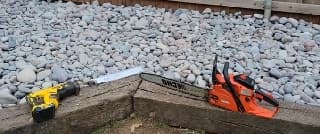As an Amazon Associate, this site earns commissions from qualifying purchases. For more information click here.
Chainsaws and reciprocating saws are both widely used for wood work, but which is more effective? Are you better off buying one, the other or both? The answer depends on the kind of projects you will be doing. Both are capable of performing similar tasks, but each excels in a specific area too.
Chainsaws are best used for large scale projects like cutting trees logs and thick branches. A reciprocating saw is more suited for smaller tasks like pruning and clearing underbrush.
Chainsaw vs. Reciprocating Saw Head to Head
If you are in a hurry, this table gives you a quick comparison of their major features. Chainsaws are more powerful in general but reciprocating saws are more versatile. This is only a general guide as manufacturers are always coming up with new features.
| Chainsaw | Reciprocating Saw | |
| Cutting Power | Can cut large tree trunks, thin metal sheet, thick branches | Tree limbs, plaster, wood, drywall and smaller materials |
| Cut Surface Finish | Rough | Reciprocating saws cut to a finer finish |
| Speed | Chainsaws can cut rapidly | Slower |
| Maintenance | High | Little required |
| Power Source | Gas, electric, battery | Electric, battery |
| Noise Level | Loud, especially if gas-powered | Quieter |
| Ease of Use | Requires more physical effort | Easier compared to chainsaws |
| Risk Level | High | Low |
| Durability | Gas chainsaws are built for heavy duty use | For light to medium scale work only |
As you can see, chainsaws and reciprocating saws have their own strengths and weaknesses. Which one you should you use depends on the job. The following are some common scenarios where you might have to choose between the two.
For Cutting Trees, Branches and Logs
A chainsaw is the best choice for cutting trees, logs, roots and thick pieces of wood. A reciprocating saw does not have the power to perform this task efficiently.
There are reciprocating saws that can cut tree trunks and thick logs. But a chainsaw can do it much faster and more effectively. Its chains rip through timber, tree trunks and assorted branches. A chainsaw packs more power in its engine and can go through large pieces of wood more easily.
To cut large trees you need a gas powered chainsaw. It must also be well maintained otherwise the chainsaw will keep cutting out. It is true that some reciprocating saws can cut a log 12 inches thick, but that is the limit. If you do this often it could wear out the motor. A chainsaw on the other hand, is built for this type of work.
Our pick here is the Husqvarna 460 Rancher Gas Chainsaw. With a 24 inch blade and 600cc 3/6 HP, it can handle almost anything you throw at it.
For Cutting Twigs, Small Trees and Pruning
A reciprocating saw is ideal for cutting small trees, small branches, twigs and pruning. Its smaller blade is suitable for this type of work. Reciprocating saws also produce a finer finish compared to chainsaws. If that is what you are looking for, this tool can do the job.
A gas chainsaw is too large to cut twigs and do pruning or trimming. You can use a small battery powered chainsaw instead. An electrical chainsaw also works fine. But in most cases a reciprocating saw will get the job done. There are many types of reciprocating saws and they are all ideal for this kind of work.
Cutting Capacity and Volume
The kind of projects you work on will determine what type of saw is best. There are a lot of options to consider but in general these are the guidelines.
- Get a chainsaw if you are going to cut large trees or volumes of wood.
- Get a reciprocating saw for smaller projects like pruning and cutting up small branches and trees.
For large projects, a gas chainsaw is the best choice. You have a lot of options and there is a model for whatever tree you have to cut, no matter how large it is. In these cases, only gas powered units will work. Corded and cordless chainsaws lack the power for this.
For small projects a reciprocating saw will be enough. Its smaller blade allows for finer cuts that a gas chainsaw cannot do. If you are looking for one, our pick is the Black and Decker 20V reciprocating saw.
Corded and cordless chainsaws are not as powerful as the gas type. But they are lighter and can be used for light tasks like a reciprocating saw.

Maintenance Requirement
Chainsaws need more maintenance. You have to supply it with fresh oil every 30 days. The engine needs to be cleaned regularly. The spark plug, air filter, fuel line, carburetor, etc. may require replacement at some point. You also have to take care of the bar and chain.
In contrast a reciprocating saw is low maintenance. Sharpen the blade when it gets dull and that is about it. After each use, wipe sawdust and dirt off and you are done. If you prefer a low maintenance cutting tool, a reciprocating saw is ideal.
Noise Level
Chainsaws are louder, no question. Gas powered models are especially loud which is why you need to wear ear protection. There are many types of saws and the chainsaw is one of the loudest.
This is not surprising because chainsaws have large, powerful engines. The cutting power you get comes at the expense of the roaring sound you hear. Electric and cordless chainsaws are quieter but also lack the power of gas models.
In contrast, reciprocating saws are much quieter. It is not silent but compared to a chainsaw the decibel level is way lower.
Durability and Reliability
Chainsaws are made for heavy duty cutting tasks. They are more durable than reciprocating saws, but you also have to consider their usage.
As already explained, a chainsaw is more applicable for large scale tree cutting projects. A reciprocating saw is more adept at smaller ones. If you use a reciprocating saw on a large tree trunk, it will fail. But if you use it for what it is intended for, then this tool will also last.
Durability and reliability also depends a lot on the manufacturer. Just like with any cutting tool, you have to buy from a known brand to ensure you get maximum value.
The longevity of any power tool depends a lot on the maintenance. A well cared for saw will last for years. If you do not maintain it, then the tool will deteriorate regardless of the brand name.
Related Questions
Which should I buy, a reciprocating saw or a chainsaw?
If you cut large tree trunks, thick branches and work with a large volume of wood, get a chainsaw. If you only need a saw for occasional or weekly pruning and cutting of small trees and twigs, a reciprocating saw is sufficient.
Can I use a reciprocating saw to cut a tree?
A reciprocating saw is used to cut branches and limbs. You can cut up to 6-12 inches in diameter, but more than that and you need a chainsaw. Using a reciprocating saw to cut tree trunks will damage its motor.
Not all reciprocating saws can cut 12 inch wood. Some are capable of just 6 inches or less. Even those that can cut 12 inch trees will wear out quickly if used repeatedly on large trunks.
Which is better, an electric chainsaw or a reciprocating saw?
An electric chainsaw is more powerful and can cut small trees faster. However a reciprocating saw is lighter and more portable. In terms of power an electric chainsaw offers more. But for safety, ease of use and low maintenance, reciprocating saws are better.
Can a chainsaw be used for trimming and pruning?
A small cordless chainsaw might do the job. The finished cut may not be as fine as a reciprocating saw. But if you are just looking for a trimming or pruning tool, it will work.
Is an electric chainsaw better at cutting small trees than a reciprocating saw?
An electric or corded chainsaw provides more cutting power. Does that make it better? It depends. If you need more power than a reciprocating saw, but do not want to buy a gas chainsaw, then an electric chainsaw will do. But if you work strictly with small trees, twigs and branches, a reciprocating saw is enough.

I love the outdoors and all the tools for maintaining gardens, yards and lawns. The only thing I am more passionate about is sharing what I know about garden and outdoor equipment.


